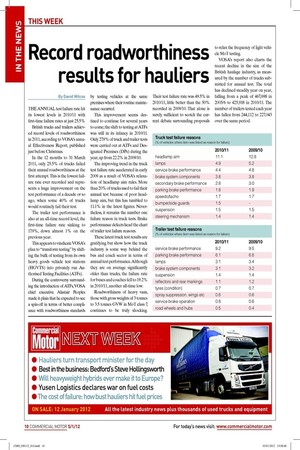Record roadworthiness results for hauliers
Page 8

If you've noticed an error in this article please click here to report it so we can fix it.
By David Wilcox THE ANNUAL test failure rate hit its lowest levels in 2010/11 with irst-time failure rates at just 25.5% British trucks and trailers achieved record levels of roadworthiness in 2011, according to VOSA’s annual Effectiveness Report, published just before Christmas.
In the 12 months to 31 March 2011, only 25.5% of trucks failed their annual roadworthiness at the irst attempt. This is the lowest failure rate ever recorded and represents a huge improvement on the test performance of a decade or so ago, when some 40% of trucks would routinely fail their test.
The trailer test performance is also at an all-time record level, the irst-time failure rate sinking to 17.9%, down almost 1% on the previous year.
This appears to vindicate VOSA’s plan to “transform testing” by shifting the bulk of testing from its own heavy goods vehicle test stations (HGVTS) into privately run Authorised Testing Facilities (ATFs).
During the controversy surrounding the introduction of ATFs, VOSA chief executive Alastair Peoples made it plain that he expected to see a spin-off in terms of better compliance with roadworthiness standards by testing vehicles at the same premises where their routine maintenance occurred.
This improvement seems destined to continue for several years to come; the shift to testing at ATFs was still in its infancy in 2010/11. Only 27.9% of truck and trailer tests were carried out at ATFs and Designated Premises (DPs) during the year, up from 22.2% in 2009/10.
The improving trend in the truck test failure rate accelerated in early 2009 as a result of VOSA’s relaxation of headlamp aim rules. More than 20% of trucks used to fail their annual test because of poor headlamp aim, but this has tumbled to 11.1% in the latest igures. Nevertheless, it remains the number one failure reason in truck tests. Brake performance defects head the chart of trailer test failure reasons.
These latest truck test results are gratifying but show how the truck industry is some way behind the bus and coach sector in terms of annual test performance. Although they are on average signiicantly older than trucks, the failure rate for buses and coaches fell to 19.2% in 2010/11, another all-time low.
Roadworthiness of heavy vans, those with gross weights of 3 tonnes to 3.5 tonnes GVW in MoT class 7, continues to be truly shocking. Their test failure rate was 49.5% in 2010/11, little better than the 50% recorded in 2009/10. That alone is surely suficient to scotch the current debate surrounding proposals to relax the frequency of light vehicle MoT testing.
VOSA’s report also charts the recent decline in the size of the British haulage industry, as measured by the number of trucks submitted for annual test. The total has declined steadily year on year, falling from a peak of 467,698 in 2005/6 to 425,918 in 2010/11. The number of trailers tested each year has fallen from 244,112 to 227,043 over the same period.













































